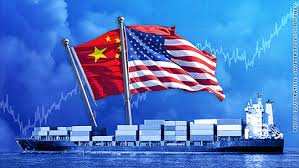How to Invest During a Trade War

President Trump wasn’t bluffing.
On Friday, the Trump administration followed through on its threat to raise import tariffs on $ 200 billion worth of Chinese goods from 10% to 25%, escalating long-simmering trade tensions between the U.S. and China to an unprecedented level.
While some would claim this a necessary maneuver in the President’s quest to recalibrate the trade dynamic between the world’s two largest economies, it’s clear that the markets aren’t too fond of the move. Monday morning brought more of the stock market declines seen last week after Trump announced the tariffs—with the Dow Jones Industrial Average down more than 550 points, the S&P 500 also dropping more than 2%, and the Nasdaq Composite falling around 3%.
Trump has indicated that he’s in no rush to strike a less-than-favorable trade deal with China, meaning that this could only be the start of a painful stretch for investors who have mostly thrived during the bull run that’s greeted the start of this year.
So, save sitting on the sidelines, what are investors to do amid a dispute that threatens to derail the rollicking U.S. economy? We took at look at which sectors will be most insulated from the macroeconomic tumult playing out right now, and which industries are most prone to feeling the impact of a full-blown trade war.
Amazon vs. Exxon
Goldman Sachs gave its take early last week, forecasting that services-oriented companies (think Amazon, Google, and Microsoft) that are “less exposed to trade policy” will likely have an easier time than goods-producing companies (such as Apple, ExxonMobil, and Johnson & Johnson) that are more vulnerable to trade headwinds.
While that’s a largely accepted view, equity and investment strategists who spoke to Fortune noted that it’s a little more complicated than that.
“The key questions to ask are: what’s priced into the market right now, what’s the direct earnings and [price-to-earnings] multiples impact, and what’s the long-term impact?” according to Savita Subramanian, head of U.S. equity and quantitative strategy at Bank of America Merrill Lynch.
Subramanian notes that many stocks with high import costs and “explicit tariff risks” have already priced in “significant multiple compression” dating back to the first round of tariffs that took effect last year, while companies with high sales exposure to China have also “reacted accordingly.” That could mitigate the consequences of newly hiked tariffs on sectors like information technology and industrials—not to mention U.S. companies affected by retaliatory tariffs on $ 60 billion worth of American goods, which China announced on Monday.
Likewise, Keith Parker, head of U.S. equity strategy at UBS, cites a February survey by the investment bank that found 75% of companies had taken “at least one action” in response to last year’s tariffs—from shifting their supply chains and moving production facilities, to front-loading imports and exports and raising prices to offset tariffs. Those moves could indicate that a “big portion of the negative impact [of tariffs] may be behind us.”
But that’s not to say that some industries aren’t still positioned to feel the pain worse than others. Parker says recent UBS research that mapped out the impact of product tariffs on specific industries found that tech and industrials would be the most affected, followed by the consumer discretionary sector (including automobiles and retail) and materials.
Safe Havens
As far as safer bets, Subramanian points to domestically-oriented companies “that have very little to do with commodity prices and credit spreads.” Health care is one such industry—despite “political election risk” characterized by the “Medicare for All” proposals coming out of the Democratic party—while pockets of the technology sector, such as software companies that are less exposed to trade than their hardware-focused counterparts, also “seem relatively immune.”
And there also sectors that are virtually entirely concerned with the U.S. economy and isolated from international trade to consider, such as utilities and real estate. Those are among “the more favored parts of the market” for those looking to avoid tariff exposure, according to Michael Reynolds, investment strategy officer at asset management firm Glenmede—though both sectors are known for steady albeit relatively low returns that may not suit those seeking greater yield.
Regardless of what industries one tries to target or avoid, finding a way to invest around something like a trade war can be exceptionally difficult. “It’s often very hard to trade around these types of events,” Reynolds says. “It’s just important to have your risk controls in place to be able to weather the storm.”
But, as most market analysts noted: All it takes is another tweet to make this all go away.
More must-read stories from Fortune:
—Warren Buffett’s best stock picks over the past year
—“Staggered” boards are paying off for stock investors
—Why “debt ceiling” may become a buzzword this summer
—Don’t miss the daily Term Sheet, Fortune‘s newsletter on deals and dealmakers


